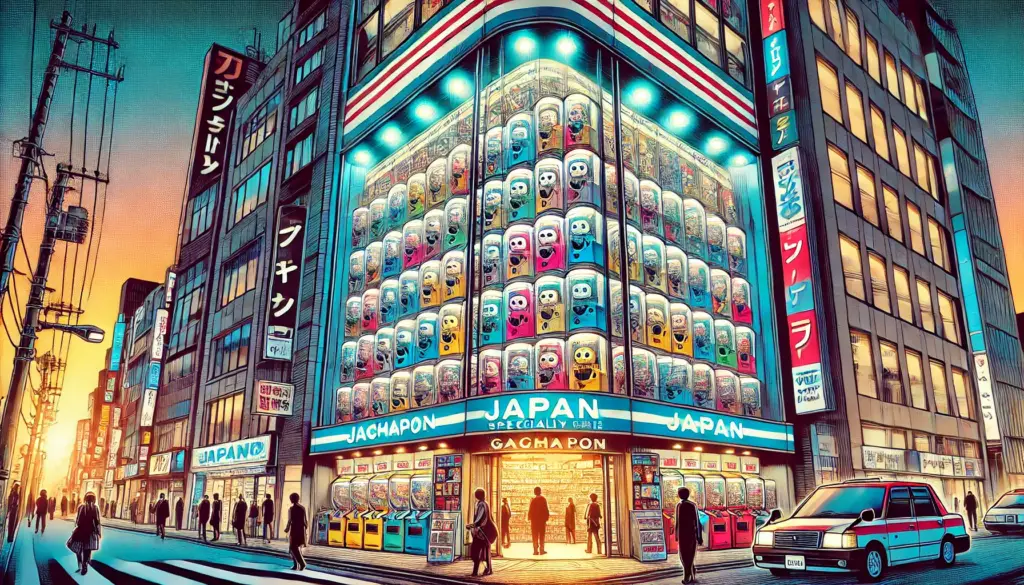
In the corners of train stations, shopping arcades, and even airports across Japan, you’ll spot rows upon rows of colorful capsule machines. Insert a few coins, twist the knob, and out pops a mysterious prize. These are Gachapon—Japan’s beloved capsule toys. But why has Japan become the undisputed king of Gachapon, producing an endless stream of wildly imaginative and often bizarre miniatures?
This blog post dives into the ecosystem that powers this uniquely Japanese phenomenon—from the behind-the-scenes planning to major collaborations with anime and corporate brands. We’ll explore the manufacturing process, the creative teams, and how these toys have evolved into both collector’s items and clever tools for brand marketing.
🎯 What Exactly Is Gachapon?
The word “Gachapon” (also spelled Gashapon) is an onomatopoeia: “gacha” for the turning of the crank, and “pon” for the sound of the capsule dropping. Originally launched in Japan during the 1960s, Gachapon were simple plastic toys aimed at children. But over the decades, they’ve transformed into a cultural staple with an audience that spans all ages.
Today, Gachapon machines are more sophisticated, the toys are higher in quality, and themes can range from cute animals in everyday situations to satirical pop culture references or hyper-detailed miniature sushi sets. Some series even include rare variants or secret items, feeding into the thrill of collection.
🔄 The Secret to Non-Stop Innovation
So how does Japan manage to keep producing fresh ideas month after month?
The answer lies in a vertically integrated and fast-moving system. Major players in the Gachapon world include:
- Bandai – The industry giant responsible for many of the most iconic series, including Pokémon, Gundam, and Dragon Ball collaborations.
- Kitan Club – Known for quirky hits like the “Koppu no Fuchiko” (a tiny woman who hangs on your cup).
- Toys Cabin – Specializing in ultra-detailed niche themes like traffic signs or rice cookers.
- Qualia and Yell – Smaller studios that often go viral for their absurd or meme-worthy figures.
These companies often work with external freelance designers or design collectives who pitch new ideas—sometimes as sketches, 3D models, or even social media posts that gain traction. If the concept looks promising, it goes into a rapid prototyping and testing phase. From idea to launch can take as little as 2 to 3 months, which is lightning-fast compared to other forms of toy manufacturing.
🛠️ From Concept to Capsule: How They’re Made
- Planning and Concept Art
Artists sketch out designs or pitch ideas. Themes might be seasonal (e.g. summer-themed cats), food-related, nostalgic, or just surreal. - Prototype Creation
3D models are sculpted and prototypes are hand-painted for approval. - Mass Production
Once approved, figures are manufactured at factories (often in China or Southeast Asia), packaged in plastic capsules, and shipped to vending hubs. - Distribution
Retailers, malls, and specialty stores lease machines and restock them regularly, often tied to regional events or product launches.
The business model thrives because it’s low risk, high novelty. A single machine costs little to maintain, and even niche themes have devoted fans. Many machines are rotated every few weeks to keep foot traffic flowing.
🤝 Collaboration with Famous IPs
One of the reasons Gachapon remains profitable is its close ties with famous IPs. Think of it as micro-merchandising. For just ¥300–¥500 (about $2–$4), fans can own a mini collectible of their favorite character.
Some examples:
- Sanrio x Sushi series – Hello Kitty characters dressed as sushi rolls.
- Pokémon Terrarium Collection – Miniature worlds in clear capsules, massively popular overseas.
- One Piece Face Magnets – Distorted character faces that went viral on TikTok.
- Evangelion Office Supplies – Yes, there was a paperclip holder in the shape of an EVA Unit-01.
These limited runs create urgency and collector culture. In some cases, figures are resold online at ten times their original value.
📣 Gachapon as Corporate Marketing
Beyond fandom, businesses are increasingly turning to Gachapon as a novel promotional tool.
Some companies now use capsule toys for:
- PR campaigns – Local governments or prefectures promote tourism by creating mascots or mini landmarks.
- Product launches – A new coffee drink? Get a matching mini keychain with purchase!
- Event souvenirs – Anime expos, pop-up cafés, and even train stations use exclusive Gachapon to boost visitor engagement.
One famous example is the Yamanote Line x Suica Penguin series, a train-themed figure set that boosted both merchandise sales and public transport branding.
🌍 Growing Appeal Among Tourists and Collectors
Gachapon culture isn’t just for locals. International travelers now plan entire stops around Tokyo’s Akihabara or Ikebukuro districts just to experience the “capsule toy walls”—massive installations with hundreds of machines.
In 2023, Japan’s largest capsule toy store, Gashapon Department Store Ikebukuro, reported over 5 million visitors annually, with foreign tourists making up 40% of that number.
It’s also gaining online traction thanks to:
- YouTube unboxing videos
- TikTok trends
- eBay resellers flipping rare items
The Gachapon scene has grown so big that some collectors now invest in full sets of capsules—never opened—hoping they’ll appreciate like trading cards.
✨ Final Thoughts: Tiny Capsules, Huge Impact
Japan’s Gachapon culture is more than a quirky novelty—it’s a powerful fusion of creativity, commerce, and culture. Behind every tiny figure lies a system of rapid design, fan engagement, and strategic branding.
Whether you’re a tourist looking for the perfect souvenir, a collector chasing rare finds, or a business trying to reach a new audience, Gachapon offers something uniquely Japanese: the joy of surprise, in the palm of your hand.



















































